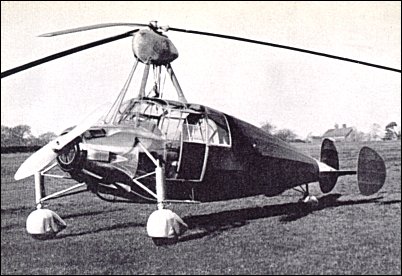It is true that man has conquered the air and annihilated distance, but his victory will not be truly complete until he is able to perform with the same degree of skill as Nature's aviators, the birds, with their control of wide speed ranges and ability to take off and land safely in very confined spaces.
Many experiments have been made to achieve this desirable end, but only with light rotating-wing—or autogiro—aircraft has any measure of success been attained. With these machines it is now possible to fly quite slowly, in perfect safety, and to take off and alight in areas comparable to the size of a tennis court, but the problems attaching to the design and operation of large commercial aircraft of this type have still to be overcome.
The development of the successful light autogiro, however, has been in two stages, the first being that in which the rotors revolved in a fixed plane in relation to the fuselage, and flight evolutions were effected by a set of normal aeroplane controls. The second stage was reached with the direct-control autogiro, in which the rotor hub could be moved and the plane of the rotors varied in relation to the fuselage, thus effecting directional control.
At this stage the question of comfort arose, and Westland, in conjunction with the Cierva Company and M. Lepere, produced the C.L.20 Autogiro, a neat two-seat side-by-side cabin machine.
This experimental aircraft, which was successfully flight-tested by the Cierva Company's pilot, Mr. R. A. C. Brie, would have undoubtedly proved extremely popular with private owners, but the shadow of impending hostilities prevented its production in quantity and closed, for the time being, Westland interest and activity in this field of aeronautics.
TYPE: Two-seat side-by-side cabin autogiro.
POWER: One 90hp Pobjoy Niagara "S" seven-cylinder air-cooled radial engine.
CONSTRUCTION: The fuselage was of welded seamless steel tubing, triangulated and faired to a streamline form by the use of stringers and fabric covering. A large door was fitted on either side of the cockpit and transparent panels, running right down to the bottom longeron, gave an excellent forward and downward range of vision. The three-blade direct control rotor was arranged to fold, to facilitate parking and storage. Three vertical fins gave directional stability, while the tailplane was designed so that the aerofoil section of one half was inverted, and set at a negative angle of incidence, to counteract airscrew torque.
A.H.Lukins "The Book of Westland Aircraft", 1943
The letters in this designation stand for La Cierva and Lepere. Lepere was at that time working with Liore and Olivier, holders of the Cierva licences for France, and it was he who designed this aircraft.
It had a 7-cylinder radial engine, and the rotor with a direct-control head consisted of three untapered blades on flapping and drag hinges. To facilitate parking in a restricted space, the blades could be folded back.
The earliest flights of this aircraft were in 1935.





